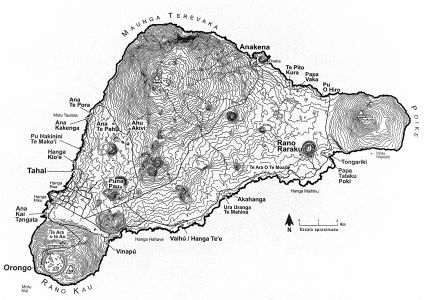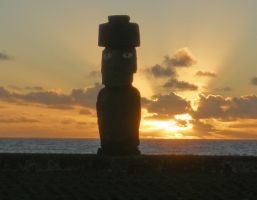
Easter Island (Polynesian name Rapa Nui) is one of the worldís most remote inhabited places, located in the Pacific Ocean about 2200 miles west of Santiago, Chile. It is volcanic in origin, shaped like a right triangle with an extinct volcano at each vertex (see map). For those familiar with the freeway system in Southern California, circumnavigating it would be roughly equivalent to driving the 91 to 55 to 405 loop, except that the roads donít actually exist on the island to make such a drive possible.
 Rapa Nui is famous for its moai, monolithic human figures carved from
stone. People think of moai as being just heads, but in actuality they
include arms, hands, and torso, although the heads are disproportionately
large. Also, many of the moai have become partially buried, leaving mainly
the head portion visible. Close to 900 moai were created, with more than
half still at Rano Raraku, the main quarry. Even more amazing are the
hundreds of moai that were somehow transported from the quarry to locations
all around the islandís perimeter. These things are huge, with some over 30
feet tall actually erected, and one incomplete one almost 70 feet tall!
Rapa Nui is famous for its moai, monolithic human figures carved from
stone. People think of moai as being just heads, but in actuality they
include arms, hands, and torso, although the heads are disproportionately
large. Also, many of the moai have become partially buried, leaving mainly
the head portion visible. Close to 900 moai were created, with more than
half still at Rano Raraku, the main quarry. Even more amazing are the
hundreds of moai that were somehow transported from the quarry to locations
all around the islandís perimeter. These things are huge, with some over 30
feet tall actually erected, and one incomplete one almost 70 feet tall!
We, with our good friends Greg and Vicki, arrived on Easter Island several days ahead of the main tour group. We were so glad we did, as it allowed us to explore the island before the population doubled in size from the influx of eclipse chasers.
One of our big accomplishments was hiking each vertex of the island. First we hiked Rano Kau, the most impressive of the three crater lakes on the island. The Orongo ceremonial village, built on the southwest rim, was central to the birdman cult, serving as the starting point for the annual race to retrieve the first sooty tern egg from the small island of Moto Nui. Easter Islandís airport, located at the base of Rano Kau, has a large airstrip which was a designated emergency landing site for the space shuttle.
We also hiked Poike, of which I remember wind/rain, cows, and very cool back views of Rano Raraku (the moai quarry) and Tongariki, where 15 moai are erected on a huge ahu (sacred platform).
By far the most amazing experience was hiking the periphery of Terevaka. It was a grueling 6-hour trek, some of it in the rain. But it was well worth the effort as its many moai, stone houses, and other stonework artifacts can only be seen by foot or horseback. The journey ended at Anakena Beach, site of more moai, including one raised by Thor Heyerdahl in the 1950ís using manual methods, and a cooking shack serving delicious tuna empanadas, an island specialty.
 We saw exactly one sunset on Easter Island, on the day of the eclipse, which
was also our last day on the island. We were so lucky the weather cleared up
just in time for the eclipse!
See
Dave's
astrophoto post for links to more photos.
We saw exactly one sunset on Easter Island, on the day of the eclipse, which
was also our last day on the island. We were so lucky the weather cleared up
just in time for the eclipse!
See
Dave's
astrophoto post for links to more photos.
Our Rapa Nui guides were wonderful, though clearly more comfortable dealing with groups of two to four people rather than double busloads (of course the same could be said of ourselves!).
We definitely would like to return to explore more of the island, under less crowded (and cheaper!) circumstances.